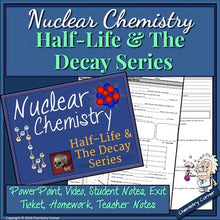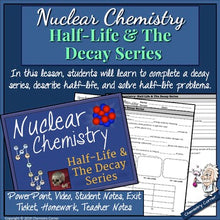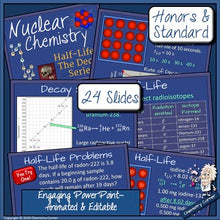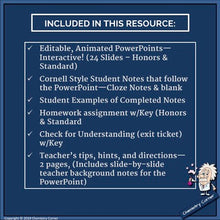Two Complete Lessons in One! This resource includes an honors level lesson and a standard level lesson!
There are two main concepts included in this lesson; half-life and the decay series. Students should understand that the decay of a radioisotope goes through a series of transmutations – usually by emitting either alpha or beta particles. Also, students should notice that the daughter nuclide of one reaction becomes the parent nuclide of the next nuclear decay.
Before we dive into some half-life problems, I have presented a few animated diagrams of what’s going on during the decay series of an element. Many students have the misconception that half of the material disappears, decays, gone forever! So here we want them to understand that they are going through a transmutation and becoming different elements by not only releasing particles, but also energy in a process to become more stable.
There are many opportunities for students to practice half-life problems with the class, with a partner, and on their own.
Lesson Objectives:
* Define half-life and decay series
* Interpret and complete a decay series
* Solve half-life problems
NGSS:
* HS-PS1-8: Develop models to illustrate the changes in the composition of the nucleus of the atom and the energy released during the processes of fission, fusion, and radioactive decay.
* SEP: Developing and using models
* PS1.C: Nuclear Processes
Nuclear processes, including fusion, fission, and radioactive decays of unstable nuclei, involve release or absorption of energy. The total number of neutrons plus protons does not change in any nuclear process.
Prior Knowledge:
Basic understanding of radioactivity, types of radioactive decay, and the symbols of radioactive particles
Writing nuclear equations
Lesson Duration: 1 class period
Included in This Resource:
* PowerPoint Presentation – Editable & Animated (Honors & Standard)
* Student Notes – Cloze Notes (Honors & Standard
* Student Notes – Blank
* Student Notes Suggested KEY
* Exit Ticket – Check for Understanding w/ KEY
* Homework w/ KEY (Honors & Standard)
* Teacher Notes
Teacher Prep Time: just print and go!
Note on the PowerPoints: The PowerPoints included in this product are editable. They are also animated, which means that they may appear busy or overlapping in the slide edit mode, but will be awesome in the slide show mode! Please don’t edit the PowerPoints until you have seen them in the slide show mode!
This lesson is appropriate for grades 9-12 chemistry
This will be a lesson you will want to use year after year!
Chemistry Corner
*************************************************************************************
Check out these other products that you may be interested in:
Nuclear Chemistry: Radioactivity & The Types of Radiation
Nuclear Chemistry: Writing Nuclear Equations
Chemistry Doodle Notes for the Year: A Growing Bundle
BellWork/WarmUps Editable For the Entire Year: Chemistry
High School Chemistry Year Curriculum
*************************************************************************************
Chemistry Corner’s PowerPoints are perfect for the flipped classroom. However, please read the Copyright Terms below before using it as such. Thanks!
LICENSING TERMS: By downloading this product, you own a license for one teacher only for personal use in your classroom. Licenses are non-transferable, meaning they cannot be passed from one teacher to another. No part of this resource is to be shared with colleagues or used by an entire grade level, school, or district without purchasing the proper number of licenses. I you are a coach, principal or district interested in transferable licenses to accommodate yearly staff changes, please contact Chemistry Corner.
COPYRIGHT TERMS: ©Chemistry Corner. Please note – all material included in this resource belongs to Chemistry Corner. By downloading, you have a license to use the material, but you do not own the material. This resource, or any portion of this resource, may not be uploaded to the internet in any form, including classroom/personal websites or network drives, unless the site is password protected and can only be accessed by students—no other teachers or anyone else on the internet.








